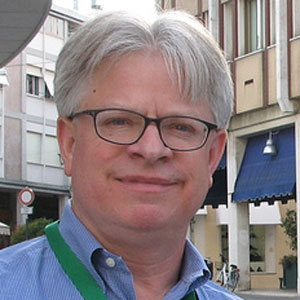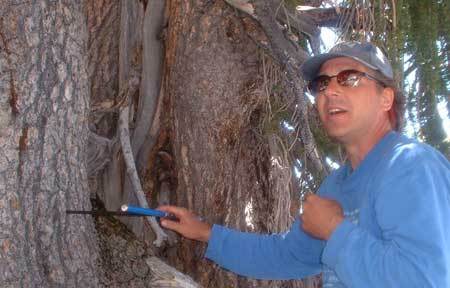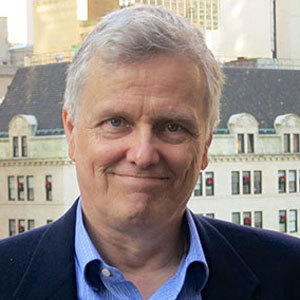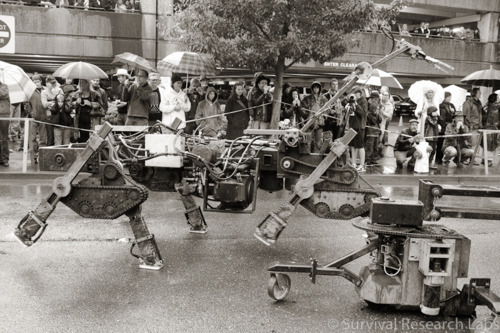Stewart Brand's Blog, page 37
November 16, 2015
“100 Years of Robot Art and Science in the Bay Area” Long Conversation November 20th 02015
On November 20, 02015, our Executive Director Alexander Rose is helping organize a free “Long Conversation” about the history of robots with UC Berkeley’s Ken Goldberg at “Friday Nights at the DeYoung”.
The event starts at 6:30, with doors at 6:00pm in the Koret Auditorium of the De Young Museum.
A “Long Conversation” is a relay style speaking event. In this case, it is a 2 hour relay of 10 minute public conversations between 11 pairs of speakers who will be speaking on “100 Years of Robot Art and Science in the Bay Area”. The conversation is part of a larger exhibit honoring the 100 year anniversary of the 1915 Panama-Pacific International Exposition. The participants of this conversation include:
Josette Melchor (Grey Area Foundation for the Arts)
Dorothy R. Santos (writer, curator)
Tim Roseborough (artist, musician, former Kimball Artist-in-Residence)
John Markoff (author of Machines of Loving Grace)
Karen Marcelo (dorkbotSF)
David Pescovitz (Boing Boing)
Catharine Clark (Catharine Clark Gallery)
Alexander Rose (director, Long Now Foundation)
Pieter Abbeel (professor, Computer Sciences, UC Berkeley)
Terry Winograd (Computer Science department, Stanford Univeristy)
Kal Spelletich (Seeman)
Artist Jenny Odell, who will be providing live images (VJing)
Friday Nights at the de Young are after-hours art happenings that include a mix of live music, dance and theater performances, film screenings, panel discussions, lectures, artist demonstrations, hands-on art activities, and exhibition tours. Local artists conduct drop-in workshops, debut new commissions, display their art in the Kimball Education Gallery, and take part in conversations about the creative process. The café offers a delicious prix-fixe menu and specialty cocktails, and the Hamon Tower observation level is open until 8 pm. Artists-in-Residence, curators, scholars, and arts educators play active roles in making Friday Nights an engaging museum experience.
We hope to see you there.

November 13, 2015
“The Forty Part Motet” by Janet Cardiff Arrives Next Door to The Interval
Fort Mason Center for Arts & Culture and the San Francisco Museum of Modern Art co-present the California debut of Janet Cardiff’s immersive sound installation The Forty Part Motet at the newly opened Gallery 308, right next door to The Interval. The Forty Part Motet is a 40-part choral performance of English composer, Thomas Tallis’s 16th-century composition Spem in Alium, sung by the Salisbury Cathedral Choir. The performance is played in a 14-minute loop that includes 11 minutes of singing and 3 minutes of intermission.
Individually recorded parts are projected through 40 speakers arranged inward in an oval formation, allowing visitors to walk throughout the installation, listening to individual voices along with the whole. Cardiff’s layering of voices creates an emotionally evocative sound sculpture that feels intimate, even within a public space.
Admission is free. Advance tickets are strongly recommended in the first weeks due to limited capacity, although same day walk-up tickets will be offered as available. The piece is open from 12pm to 8pm Wednesdays through Sundays from November 14, 02015 to January 18, 02016 – do come by The Interval for a cocktail or coffee afterwards!

November 12, 2015
Steven Johnson takes a Long Now Perspective on the Superintelligence Threat
Steven Johnson, former Seminar speaker & author of How We Got to Now, recently wrote on the dangers of A.I. on his blog “How We Got To Next“. He discusses evolutionary software, the existential threat of A.I., before concluding with a meditation of long-term thinking and The Long Now Foundation:
One of the hallmarks of human intelligence is our long-term planning; our ability to make short-term sacrifices in the service of more distant goals. But that planning has almost never extended beyond the range of months or, at best, a few years. Wherever each of us individually happens to reside on Mount Einstein, as a species we are brilliant problem-solvers. But we have never used our intelligence to solve a genuinely novel problem that doesn’t exist yet, a problem we anticipate arising in the distant future based on our examination of current trends.
“This is the function of science fiction. To parse, debate, rehearse, question, and prepare us for the future of new.”
To be clear, humans have engineered many ingenious projects with the explicit aim of ensuring that they last for centuries: pyramids, dynasties, monuments, democracies. Some of these creations, like democratic governance, have been explicitly designed to solve as-of-yet-undiscovered problems by engineering resilience and flexibility into their codes and conventions. But mostly those exercises in long-term planning have been all about preserving the current order, not making a preemptive move against threats that might erupt three generations later. In a way, the closest analogue to the current interventions on climate (and the growing AI discussion) are eschatological: in religious traditions that encourage us to make present-day decisions based on an anticipated Judgement Day that may not arrive for decades, or millennia.
No institution in my knowledge has thought more about the history and future of genuinely long-term planning than the Long Now Foundation, and so I sent an email to a few of its founders asking if there were comparable examples of collective foresight in the historical record. “The Dutch in planning their dykes may have been planning for 100-year flood levels, and the Japanese apparently had generational tsunami levels for village buildings. However, both of these expectations are more cyclical than emergent,” Kevin Kelly wrote back. He went on to say:
I think you are right that this kind of exercise is generally new, because we all now accept that the world of our grandchildren will be markedly different than our world — which was not true before.
I believe this is the function of science fiction. To parse, debate, rehearse, question, and prepare us for the future of new. For at least a century, science fiction has served to anticipate the future. I think you are suggesting that we have gone beyond science fiction by crafting laws, social manners, regulations, etc., that anticipate the future in more concrete ways. In the past there have been many laws prohibiting new inventions as they appeared. But I am unaware of any that prohibited inventions before they appeared.
I read this as a cultural shift from science fiction as entertainment to science fiction as infrastructure — a necessary method of anticipation.
Stewart Brand sounded a note of caution. “Defining potential, long-term problems is a great public service,” he wrote. “Over-defining solutions early on is not. Some problems just go away on their own. For others, eventual solutions that emerge are not at all imaginable from the start.”
Read the full article on Steven Johnson’s blog

November 10, 2015
Lost Landscapes of San Francisco 10 Seminar Tickets
The Long Now Foundation’s monthly
Seminars About Long-term Thinking

Rick Prelinger presents
“Lost Landscapes of San Francisco, 10″
TICKETS
Wednesday December 9, 02015 at 7:30pm Castro Theater
Long Now Members can reserve 2 seats, join today! General Tickets $15
About this Seminar:
The 10th annual screening of Rick Prelinger’s archival tour of San Francisco’s past (and anticipation of its future) happens again at San Francisco’s historic Castro Theatre on December 9.
Combining favorites from past years with this year’s footage discoveries, this feature-length program shows San Francisco’s neighborhoods, infrastructures, celebrations and people from 01906 through the 01970s. New sequences this year include 01930s scenes in downtown taverns, New Deal labor graphics and an exuberant 01940s Labor Day parade, radical longshore workers, newly discovered World War II-era tourist-shot Kodachrome, residential neighborhood activities and much more.
As always, the audience makes the soundtrack at the glorious Castro Theatre! Come prepared to identify places, people and events; to ask questions; and to engage in spirited real-time repartee with fellow audience members.

Ryan Phelan speaking at World Wildlife Fund Fuller Symposium
On November 18 02015, Ryan Phelan, Executive Director of Revive and Restore, will be speaking at the Fuller Symposium in Washington D.C. on how recent advances in biotech can aid conservation efforts.
This event is free, and can be viewed online via its live stream or in person in Washington D.C. on November 18th from 9:00AM to 5:45PM EST, Ryan Phelan’s talk is at 3:50PM EST.
You can RSVP to the symposium and watch the live stream on November 18th here.
The Fuller Symposium is a project of the World Wildlife Fund & Fuller Science for Nature Fund, which “supports and harnesses the most promising conservation science research and puts it into practice.”
Today, more than ever, we depend on innovations in technology for our work, health and daily lives. Technological breakthroughs are changing the way we address some of the most pressing issues threatening our planet—from providing new tools to monitor illegal activity from the sky to using eDNA to inventory biodiversity from a single drop of water. Scaling innovative solutions requires learning from other sectors and tracking emerging opportunities.
The 2015 Fuller Symposium on November 18th will bring together thought leaders in science, policy, business, conservation and development to tackle the emerging issues facing our planet. This year’s symposium will explore current uses of innovative technology and the promises and perils they present for addressing some of the planet’s greatest challenges.

November 5, 2015
James Fallows gives update to his “Civilization’s Infrastructure” Seminar
We under-imagine benefits and over-imagine problems with civilian infrastructure projects, yet we do the opposite with military infrastructure-scale weapons systems. Both behaviors defy reason and cause harm.
– Stewart Brand
James Fallows recently wrote a piece for the Atlantic describing common bias in dealing with military infrastructure vs. public infrastructure, expanding on the themes he talked through at last month’s Seminar, “Civilization’s Infrastructure“.

November 3, 2015
MIT Paleoclimate Study Reveals When the American West Dried Up
We know that the American West was once much wetter than it is today; the region is riddled with ancient lake beds and fossilized aquatic creatures. At some point in the last 15,000 years, these inland seas disappeared and turned to desert – but exactly when this happened was not well known.
Until recently: a group of MIT researchers has discovered that the American west must have dried up just about 8,200 years ago – and that it did so relatively rapidly.
They came to this conclusion by studying stalagmites found inside a cave in the Nevada Great Basin. Stalagmites – rock formations that grow upwards on the floor of a cave from material that drips down from the ceiling – are “deposited in layers, kind of like stacked traffic cones,” says David McGee, an MIT paleoclimatologist and leader of the research team.
“Each year’s drips make a new coating, and when you cut them open, they have a very clear set of layers, and a clear sense of this is older, this is younger. So they have stratigraphy to them, which is important to us.”
The team was able to date each layer by calculating its ratio of Uranium to Thorium isotopes – a common way to determine the age of limestone. The researchers then looked at the mineral composition of each layer, and realized that it gave an indication of the moisture content that must have been present in the soil above ground at the time each layer was deposited. ”I’ve heard stalagmites called ‘fossilized groundwater,’ and that’s essentially what they are,” McGee explains. “Groundwater is percolating through the soil and rock, gets to the cave and drips out, and precipitates this stalagmite. The chemistry of that groundwater tells us something about the conditions outside the cave.” Groundwater contains large quantities of calcium and magnesium. As it seeps downward through the soil it leaves that calcium behind, leaving the water that ultimately drips into the cave with a relatively high concentration of magnesium. The research team realized that a drier climate slows down this percolation of water through soil, resulting in more calcium deposits in the ground, higher magnesium concentrations in the water that entered the cave, and thus higher levels of magnesium in the stalagmite layers that correspond to a dry period.
Analysis revealed a marked and steep rise in the concentration of magnesium in stalagmite layers that began about 8,200 years ago. It marks a major climatic change – one that must have affected the way people lived at the time. Exactly what caused this drying out remains a mystery, though McGee has an idea:
One of the big things that was happening at this time worldwide was the collapse of the last vestiges of this big ice sheet in Canada,” McGee says. “An ice sheet is thought to have important effects on where the jet stream goes. By having this ice sheet here, it made it so the jet stream was more likely to bring storms into the American West, and when it collapsed, the region became more like it is today.
The MIT study complements other ongoing analyses of long-term Great Basin climate change, including ones that are hosted and facilitated by Long Now itself: our Nevada property is one of several field locations used by researchers Scotty Strachan and Matt Salzer (pictured below), who study bristlecone core samples and weather station data to study long-term trends in weather patterns – such as moisture content in the air, or the amount of sunlight per year – across a variety of Great Basin microclimates.
 Studies like these not only help us understand how our landscape came to look the way it does, but also create a larger picture for us of long-term climate change and its impact on human civilization – much like former SALT speaker Stefan Kroepelin does in the Sahara. This larger picture can help us better assess the meaning of more short-term weather fluctuations, and help us predict what may happen – and how we should respond – as we see our planet warming up.
Studies like these not only help us understand how our landscape came to look the way it does, but also create a larger picture for us of long-term climate change and its impact on human civilization – much like former SALT speaker Stefan Kroepelin does in the Sahara. This larger picture can help us better assess the meaning of more short-term weather fluctuations, and help us predict what may happen – and how we should respond – as we see our planet warming up.

November 2, 2015
Real Future Fair and STEAM Carnival
We have arranged discounts for our members at 2 upcoming events in San Francisco; the STEAM Carnival and the Real Future Fair, where our Executive Director Alexander Rose will be speaking.
If you’re a member, more info on both of these events and instructions on how to access your member discount can be found in your inbox. We hope to see at either these events or one of our upcoming Seminars or Interval talks!

STEAM Carnival is 100,000 square feet of fun taking place at Pier 48 in San Francisco, November 6-8, 2015. The event captures the imaginations of adults and kids alike with a special focus on igniting interests in Science, Technology, Engineering, Art and Math (STEAM). The event features high-tech games, interactive installations, dynamic build zones, round the clock stage shows, lab demos, aerialists, artists, food, and more. The event is open from Friday from 10am-5pm, and Saturday & Sunday from 10am-6pm at Pier 48 at AT&T Park.
Check your email for a code to save $5 on tickets, which are available here.

The Real Future Fair will be held at the Innovation Hangar in San Francisco on Friday November 6 and Saturday November 7, 02015. Long Now’s Executive Director Alexander Rose will be speaking on Saturday afternoon at 4:00pm.
On Friday, The Real Future Forum presents “creative conversations about how technology is changing our world”, followed by a Robot Cocktail party. Saturday is The Real Future Fair, “a day-long civic event, featuring drone demonstrations, a robot petting zoo, a retro future film screening and programming from Code for America, the Bay Area Video Coalition, Counterpulse and The Long Now Foundation.”
Members receive 40% off of ticket prices with the discount code in your inbox, tickets available here.

October 29, 2015
10,000 Years of Oral Narrative
Just off the coast of Australia, a few miles west of Perth, lie three small limestone islands. Today they’re a popular destination for boat trips and air taxis, but a local Aboriginal tribe tells stories of a time when these three isles were connected to the mainland by lush forest. One day, the stories recount, those trees caught fire. They burned “with such intensity that the ground split asunder with a great noise, and the sea rushed in between, cutting off these islands from the mainland.”
Along Australia’s Southern coast, another Aboriginal community tells an old story about marital strife, in which an angry ancestral figure called Ngurunderi chased his wives across the tribe’s territory until they sought refuge on a piece of land known today as Kangaroo Island. To punish his wives, Ngurunderi caused the seas to rise and turned his wives into large coastal rocks. The last time anyone would have been able to travel to Kangaroo Island on foot was about 10,000 years ago, when sea levels were about 100 feet lower than they are today.
That time span begins to enter the realm of the mythic. Few, if any, man-made things survive that long, let alone an oral anecdote about the environment. Does that mean, then, that these stories are just that – fairy tales of the kind we all grow up with? Nicholas Reid and Patrick Nunn think not. A linguist and geologist, respectively, Reid and Nunn collected similar stories from all over Australia. Matching each of them successfully to actual historical changes in the continent’s shoreline, they argue that these narratives originate in fact – and that they must, therefore, have been passed from generation to generation for many thousands of years, all without the aid of being written down.
Throughout human history, oral narratives have been an important way for communities to pass knowledge from generation to generation. Many of the oldest epics known to us today – that of Gilgamesh, the Odyssey, or the Mahabharata, to name just a few – lived long lives as oral poems before they were ever committed to paper. The blend of flowery language, rhyme, and meter so typical of these stories helped narrators commit them to memory, and brought them to life for communities with every telling. In this way, oral poetry long served as a central repository of shared beliefs, values, and knowledge for pre-literate societies around the world. They offered a sense of intergenerational continuity, and helped communities understand their history and their world.
The oldest epics known today are a few millennia old, but none come close to the age Reid and Nunn suggest for these Aboriginal tales – the team estimates most of them to be between 8,000 and 12,000 years old, to match the sea level changes they purportedly recount. This stretch of time would be unprecedented, but not necessarily impossible. If the knowledge conveyed in a story is considered important enough to a community’s sense of identity, for example, its narrative is likely to keep being told and retold from generation to generation. And if a society places more value on accuracy than on creative innovation, its tales are less likely to evolve much in their content. Reid and Nunn argue that both are true of Aboriginal cultures:
Reid says clans have very specific mechanisms for teaching people to tell oral histories, as well as tasking others to ensure the orator tells stories accurately. For instance, when children are told tales by their parents, they are tasked with quizzing the details and cross-checking them with their grandparents. “People take these relationships very seriously,” says Reid. “The beauty of the relationship is that it is cross-generational and that provides a kind of scaffolding that’s very successful at keeping stories accurate, not succumbing to a [game of telephone] effect.” This feature of oral tradition appears to be specific to Australia.
The possibility that these stories are truly as much as 12,000 years old does not yet prove their factuality. Investigating whether these tales originate in truth will involve analyzing the likelihood that disparate Aboriginal tribes across Australia would have all simply conjured mythic stories about rising sea levels – or that a single story would have been shared and adapted by societies across the continent. Reid and Nunn believe it’s more plausible that each community would have witnessed such flooding in their own territory and considered it momentous enough to pass the experience on to their descendants. They argue that the narratives are too similar across groups who are unlikely to have exchanged tales with one another; and too specific to local contexts to have been borrowed from elsewhere.
How do we know that these stories are authentic? We suggest that because they all say essentially the same thing, it is more likely that they are based on observation. All tell of the ocean rising over areas that had previously been dry. None tell stories running the other way – of seas falling to expose land. The huge distances separating the places from which the stories were collected – as well as their unique, local contexts – makes it unlikely that they derived from a common source that was invented.
In the end, the factuality of stories like these may be impossible to determine, and the definition of ‘authenticity’ may be up for debate. With narratives this old, the distinction between ‘myth’ and ‘fact’ may have simply faded, or disappeared altogether. Myth can become a means to convey the emotional force of long-ago experiences, events witnessed by ancestors so old that they’ve become more abstract than real. In turn, historical snippets or location-specific details may be woven into mythic stories to aid their resonance with listeners. But whether you choose to class these tales as fact or fiction, the research done by Reid and Nunn does suggest that oral narratives should never be dismissed as irrelevant to our understanding of local histories. However you define “truth,” such stories can be repositories for cultural knowledge, beliefs, and shared experiences across massive stretches of time – they become the stuff of a community’s long-term continuity.
This paper makes the case that endangered Indigenous languages can be repositories for factual knowledge across time depths far greater than previously imagined … forcing a rethink of the ways in which such traditions have been dismissed.

October 28, 2015
Philip Tetlock Seminar Tickets
The Long Now Foundation’s monthly
Seminars About Long-term Thinking

Philip Tetlock presents “Superforecasting”
TICKETS
Monday November 23, 02015 at 7:30pm SFJAZZ Center
Long Now Members can reserve 2 seats, join today! General Tickets $15
About this Seminar:
The pundits we all listen to are no better at predictions than a “dart-throwing chimp,” and they are routinely surpassed by normal news-attentive citizens. So Philip Tetlock reported in his 02005 book, Expert Political Judgement—and in a January 02007 SALT talk.
It now turns out there are some people who are spectacularly good at forecasting, and their skills can be learned. Tetlock discovered them in the course of building winning teams for a tournament of geopolitical forecasting run by IARPA—Intelligence Advanced Research Projects Activity. His brilliant new book, SUPERFORECASTING: The Art and Science of Prediction, spells out the methodology the superforecasters developed. Like Daniel Kahneman’s THINKING, FAST AND SLOW, the book changes how we think about thinking.
Philip Tetlock is a professor at the University of Pennsylvania. With his co-researcher (and wife) Barbara Mellors he is running the Good Judgement Project, with its
Stewart Brand's Blog
- Stewart Brand's profile
- 291 followers













